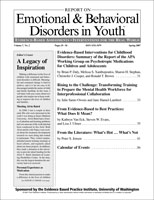Complete Issue
Author: Abby Albright Bode.; Joni Williams Splett.; Melissa W. George.
Source: Volume 15, Number 01, Winter 2015 , pp.1-28(28)

< previous article |return to table of contents
Abstract:
This issue of the Report on Emotional & Behavioral Disorders in Youth includes three papers that highlight the role of schools in providing psychosocial supports to youth. Specifically, these papers address the potential for schools to improve student-teacher relations, assess multiple domains of student engagement to improve retention, and discuss interventions for reducing rates of teen dating violence. Emotional Labor and Therapeutic Alliances for Youth With Emotional and Behavioral Disorders. The first article, by Levine Brown, Valenti, and Kerr, focuses on teacher-student relations and the influence of teachers’ emotional labor on their ability to form alliances with students with EBDs. The authors explore whether different types of emotional acting and the degree to which teachers display their natural emotions have differential effects on establishing a bond with students. Through interviews and standardized measures, they find that teachers’ emotional responses, particularly their use of natural expressions, may contribute to forming stronger relationships with their students. The results highlight the need for teachers to recognize how to display emotional responses that can facilitate modeling and social learning to best support the needs of students with EBDs. Student Engagement for Youth With Emotional and Behavioral Problems. The second paper, by Monahan and colleagues, emphasizes the need to account for all domains of student engagement in school—academic, behavioral, psychological, and cognitive—in order to better understand associations with school dropout, especially given the troubling rates of high school dropout among students with EBDs. This paper highlights the current state of research, which is more likely to account for academic and behavioral engagement indicators, rather than cognitive and psychological engagement risk factors, as early signs of risk for dropout. In examining 647 high school students who participated in a national study focused on increasing academic and emotional supports in the school setting for youth with EBDs, the authors find that higher intensity of internalizing symptoms was related to lower cognitive and psychological engagement and higher behavioral engagement, and that a higher level of externalizing symptoms was associated with lower behavioral and academic engagement. Thus, researchers and practitioners may need to further consider the roles of psychological and cognitive realms of student engagement among youth with EBDs in addition to the more traditional academic and behavioral indicators. Preventing Teen Dating Violence. The third article, by Whitaker and Savage, provides a comprehensive synthesis of teen dating violence prevention programs that are designed to act on multiple levels of analysis, such as the community level (including school climate), relationship level, and individual level. The authors find that there are prevention programs in place that span the levels of analysis, with most programs for school-aged youth targeting outcomes at the individual level. These programs show promising results, particularly in improving youths’ attitudes and knowledge regarding teen dating violence. Individually targeted programs that include interventions at the community and relationship levels are also shown to result in some behavioral change. Thus, individual level strategies can be enhanced by including strategies reaching higher levels, such as influencing the culture of the community and emphasizing relationship supports. School Connectedness. Although offering programs within the school context increases youths’ access to such supports, focusing on factors that increase students’ connectedness to the school—e.g., fostering strong student-teacher bonds and increasing awareness of student engagement indicators—may also help to reduce barriers to learning and increase retention. This issue of EBDY presents examples of important engagement indicators in order to build researchers’, educators’, and practitioners’ awareness and understanding of the factors that may increase students’ capacity to learn and engage with the school environment. The complete issue also includes a calendar of meetings and our regular review of the research literature, “What’s Hot … What’s Not” by Lorraine Dubuisson.Keywords: Therapeutic alliance; student engagement; teen dating violence
Affiliations:
1: University of South Carolina; 2: University of South Carolina; 3: University of South Carolina.